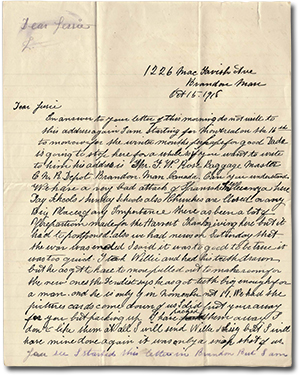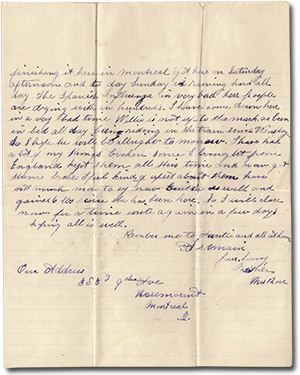The 100th anniversary of the First World War is now finished but the records will continue to be preserved at the Archives and accessible to current and future generations who want to know more about the time period. In addition, this blog will remain on our website as an additional resource.
October 2018 Posts:
- 29 October: Lilia May Cox and George N. James
- 22 October: Influenza in Brandon and rumours about the end of the war
- 15 October: Spanish Influenza in Labrador: One fur trade post's story
- 9 October: Edith Rogers and the war effort on the home front
- 1 October: Shooting Straight: The Winnipeg Civilian Rifle Association and the First World War
29 October 2018
Lilia May Cox and George N. James
Lilia May Cox (1869-1956), only daughter of Levi and Mary Erb, moved to Winnipeg from Ontario with her parents when she was a young child. She married F. J. C. (Fred) Cox in 1888 and the couple lived with Lilia’s parents at “The Grange”, 330 Anderson Avenue, Winnipeg.
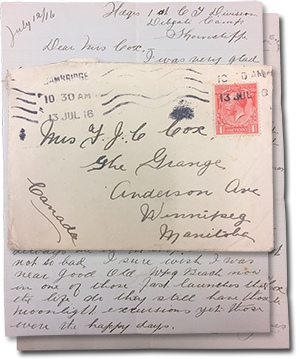
(3 images)
The couple did not have children but, during the First World War, Lilia wrote to a number of young men – family members, friends and former employees – and sent them parcels of food and other items. A number of letters received by Lilia May Cox from these young men, which refer to the letters and parcels she sent to them, were donated to the Archives of Manitoba by the owner of The Curiosity Shop, in 2005. (See our 5 September 2017 blog on the records of Campbell Millar which were acquired at the same time.)
One of these young men with whom Lilia May Cox corresponded was George N. James, the Cox’s chauffeur and mechanic before he enlisted in August 1915. George N. James’ letters to Mrs. Cox recall the car he drove for them and how well it did even in bad weather. He tells his former employer about the various vehicles he is driving for the army and how much he wants to go to the Front. He tells her when he’s found a piano to play and how much everyone enjoys his music. He remembers great times at Winnipeg Beach and wishes he was there.
George N. James died of wounds on 8 September 1918 after being shot in the right leg and abdomen. His father and sister, William James and Lilian James of 532 Tylehurst Street, Winnipeg, received news of his death. George’s sister then writes twice to Lilia May Cox to inform her of George’s death, to let her know how much they appreciated that Mrs. Cox wrote to George (he had told his family in his letters to them) and to forward a copy of the letter sent by Major Lynn, passing on his condolences.
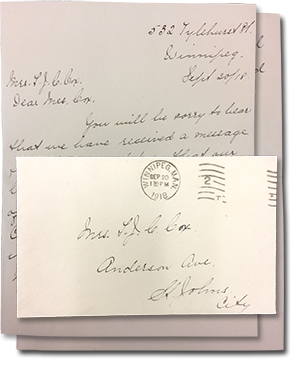
(3 images)

The letters from and about George N. James are only a few in number but they provide an interesting glimpse into the life and service of another Manitoban soldier and his continuing relationship with his former employer, Lilia May Cox.
Search Tip: Search “Lilia May Cox” in Keystone for more information.
Feedback
E-mail us at [email protected] with a comment about this blog post. Your comments may be included on this page.
22 October 2018
Influenza in Brandon and rumours about the end of the war
As mentioned in our 12 February 2018 blog post, Jessie Ambrose’s mother, Annie Rose, sent letters from Manitoba to her daughter in England. Mrs. Rose began writing a letter from her family’s home in Brandon on 15 October 1918, letting Jessie know of their plans to leave for Montreal the following day, for the winter and possibly for good. Mr. Rose was to remain in Brandon for the time being.
Mrs. Rose described the impact of the Spanish influenza epidemic and also rumours about the end of the First World War.
“We have a very bad attack of Spanish Influenza here. Day Schools & Sunday Schools also Churches are Closed or any Big Places of Importance. There as [sic] been a lot of preparation made for the Harvest Thanksgiving here but it had to postponed. Also we had news on Saturday that the war was ended I said it was to [sic] good to be true it was too quick.”
Mrs. Rose completes the letter after arriving in Montreal, where the influenza epidemic was also raging:
“You see I started this letter in Brandon But I am finishing it here in Montreal got here on Saturday afternoon and to day Sunday is raining hard all day. The Spanish Influenza is very bad here people are dying with in hundreds. I have come down here in a very bad time. Willie is not up to the mark as [sic] been in bed all day being riding in the train since Wensday [sic]. So I hope he will be allright [sic] tomorrow. I have had a lot of my things broken some I brought from England kept them all this time and now got them broke I feel kind of upset about them have not much more to say now Cecilia is well and gained 6 lbs since she has been here. So I will close now for a time write again in a few days hoping all is well.
Remember me to Auntie and all at home
I remain
Your loving Mother,
Mrs. Rose”
Later letters show that both of Mrs. Rose’s children, William and Cecilia were very sick with the flu but both recovered. Due to the expense of being in Montreal, Mrs. Rose and the children returned to Brandon in December.
Search Tip: Search “Jessie Ambrose” in Keystone
to find a description and listing of these records.Feedback
E-mail us at [email protected] with a comment about this blog post. Your comments may be included on this page.
15 October 2018
Spanish Influenza in Labrador: One fur trade post's story
The Spanish Influenza pandemic of 1918-1919 caused a worldwide health emergency in a world already suffering from a long war. Between March 1918 and Summer 1919, the flu infected around 500 million people worldwide and killed between 20 and 40 million of these, including around 30,000 Canadians. Labrador was particularly hard hit, with 10 per cent of its population wiped out from the flu, including one third of the region’s Inuit population. In some cases, entire communities vanished.
The 1916-1919 journal kept at Cartwright, an HBC post on the Labrador coast, provides an intimate glimpse into life during the worst months of the flu epidemic, particularly November and December 1918.
Post journals generally document weather, daily activities, occurrences of note, arrivals and departures of visitors, and trading activities. However, they also report on extraordinary events that affected the life and work at the posts. This journal mixes the routine reporting on post activities with daily updates on the toll the flu was taking on Cartwright and the surrounding area – tallies of the sick, as well as those who had passed away. It also notes the HBC employees who were off work to tend to sick loved ones, were attending funerals, or had travelled to other stricken communities to help.
The first mention of Spanish Influenza is in the entry dated October 31, 1918:
“Owing to sickness and irregularities of servants duties this log has not been written up since September 23rd.”
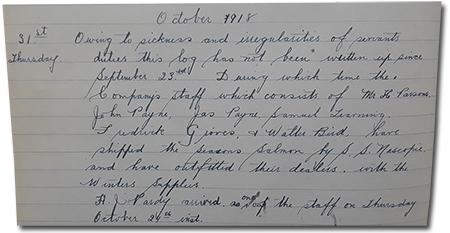
Here are some other select excerpts from the Cartwright post journal, November and December, 1918:
Nov 7:
“By phone from Muddy Bay we hear that all the people are down with La Grippe (if it may be defined as such).”
Nov 13:
“Clear and fine to-day with strong breeze from North West at a.m. moderating a little during p.m. Again – Again – When will it end? We are still at odd jobs around the post. Three of our servants are still ill with the Flu; But as there are three trusty servants, we will come off – yea – more than conquerors.”
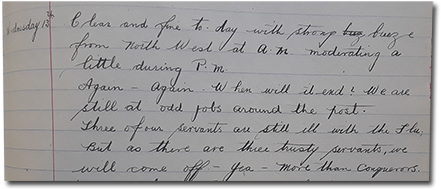
Nov 21:
“William Learning arrived from North River to-day and reported that ten persons had died at that place from the Flu and that none were buried, accordingly S.H. Parsons, Rev’d Gordon, E.P. Clarke, E. Doan and Roland McDonald left here in motor boat about four P.M. to try and cope with the difficulties.”
Dec 1:
“Owing to the Epedimic [sic] which has prevailed here for some time the church services have not been continued.”
Dec 9:
“E.P. Clarke from Porters Post left for Paradise to-day. Robert Mesher & John Lethbridge arrive from the above mentioned place to-day and from them we learn that twenty persons have passed away with Spanish Influenza. Which makes as far as we know to present a total of forty six persons for Cartwright District, but up to the present time we have not heard from the north side of the Bay, but are expecting to hear news of more deaths very shortly.”
Dec 16:
“To day also we learn that seven other persons have died from Spanish Influenza on the North side of Sandwich Bay.”
Dec 24:
“Snow storms during A.M. Colder and Fine during P.M. Servants to-day giving the Post a cleaning up. Preparatory to Christmas. Owing to the usual Post Work being behind hand, owing to sickness of the staff the usual week of holidays will be limited to three: ie. Dec. 25th & 26th and January 1st 1919.”
Dec 25:
“At six P.M. to-day Rev’d Gordon held the annual Xmas Tree celebration, for the children, which proved a great success. Owing to so many deaths occuring this fall and winter no sports were held by any of the older people to-day.”
After Christmas 1918, the flu is rarely mentioned in the Cartwright post journal. The daily entries return to their usual reporting on the business of the fur trade.
Search Tip: For more records related to HBC’s posts in Labrador, search “Labrador” or by individual posts’ names in Keystone.
Feedback
E-mail us at [email protected] with a comment about this blog post. Your comments may be included on this page.
9 October 2018
Edith Rogers and the war effort on the home front
In 1920, Edith Rogers became the first woman to be elected to the Manitoba Legislature. Like many Manitoba women, during the First World War she was involved in a number of organizations aimed at supporting the war effort including the Central Auxiliary for War Relief Work, the Convalescent Hospital, and the Ladies' Auxiliary of the Winnipeg Great War Veterans’ Association. She was an advocate for soldiers' dependents and was active in the Manitoba Patriotic Fund, which assisted families of soldiers serving overseas and became known as the Soldiers’ Deserted Wives Fund following the war.
Rogers was also a trustee for the Women’s Tribute to Veterans of the Great War, which was organized in 1917. According to the organization’s constitution, its aim was “To unite all the women of Manitoba in an effort for the raising of a Tribute to all the Veterans of the Great War who have returned, and a fitting Memorial for those who have not returned.”
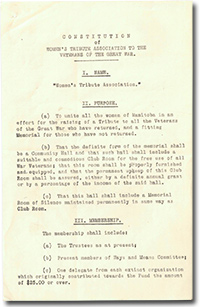
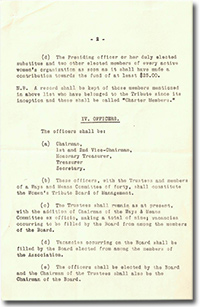
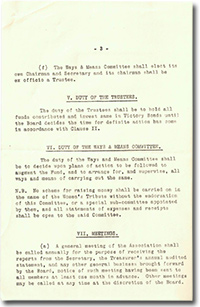

The Women’s Tribute Memorial Lodge was opened in 1931 at 200 Woodlawn Avenue after several years of fundraising. The building served as a clubhouse for veterans of the First World War.
Rogers’ effort on behalf of soldiers and their families was cited as one of several examples of her commitment to public service in a circular produced by the Ladies’ Auxiliary of the Great War Veterans’ Association to promote Rogers’ re-election in 1922.

“We have been closely associated with her during the past eight years and we know how keen is her devotion to the public interest. She has been more active, and more effective, in good works than any other woman in Winnipeg, and her zeal has never faltered even in the most trying circumstances. Her principal concern, of course, has been for the soldiers and their families. She has recognized the obligation the community owes to the men who served overseas, and has been ready to assist and encourage them in every way.”
Edith Rogers was re-elected in 1922 and held her seat until she retired in 1932. Following her retirement from politics, Rogers spent time travelling. When the Second World War broke out, she returned to Winnipeg where she was elected chair of the provincial war council of the Red Cross and provincial organizer of voluntary registration of Canadian women. In 1942, Rogers returned to Ontario. She died in Colborne, Ontario in 1947.
Search Tip: Search “Edith Rogers” in Keystone to find a description and listing of these records.
Feedback
E-mail us at [email protected] with a comment about this blog post. Your comments may be included on this page.
1 October 2018
Shooting Straight: The Winnipeg Civilian Rifle Association and the First World War
The Winnipeg Civilian Rifle Association (WCRA) was founded in 1900. It held shooting competitions and provided firearms training in Winnipeg.
At the outbreak of the First World War, the military preferred enlistees to have experience handling firearms before they volunteered. To fulfill this need, organizations such as the WCRA decided, with permission from the military, to provide basic firearms training for civilians before they enlisted.
In a 1915 letter to Colonel H.N. Ruttan of Fort Osborne Barracks, the WCRA (then known the Winnipeg Rifle Association) described their training methods:

The plan which we followed in order to avoid accidents, save time and give efficient instruction was to take all the rifles to the range in one conveyance, under guard, to place one of our instructors on the mound before each target and to give him three rifles to look after. Three men were called upon and sent to each instructor who handled all the ammunition, watched that no accidents occurred and gave personal instruction to each man.
The letter goes on to request more rifles and ammunition for the association so that they can “give some rudimentary drilling under instruction by some of our members, who are qualified, but who are not at present attached to the active militia.” The WCRA continued to provide firearms training to civilians throughout the First World War and beyond.
Search Tip: Search “Winnipeg Civilian Rifle Association” in Keystone to find a description and listing of these records.
Feedback
E-mail us at [email protected] with a comment about this blog post. Your comments may be included on this page.



